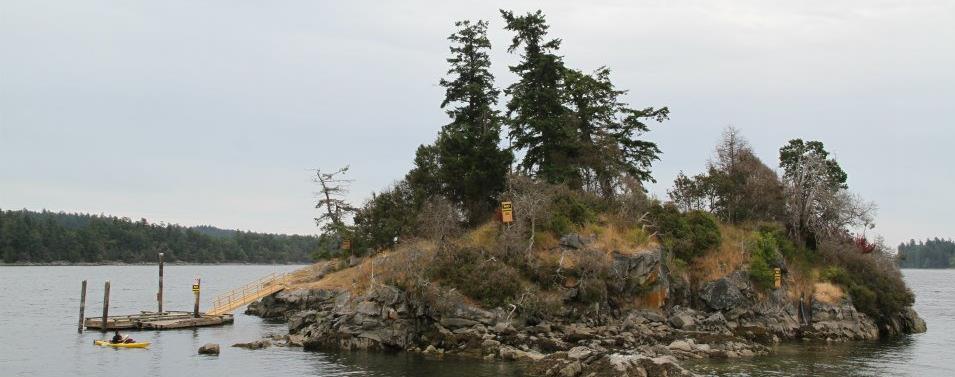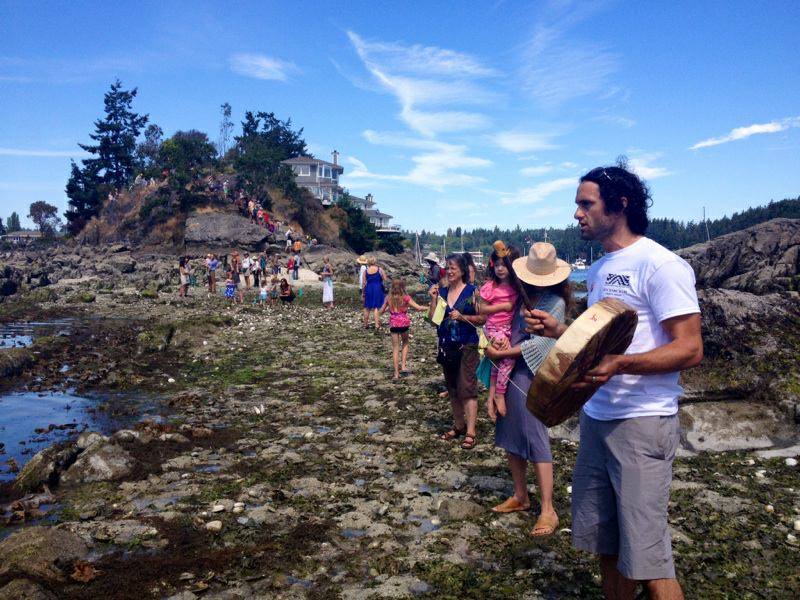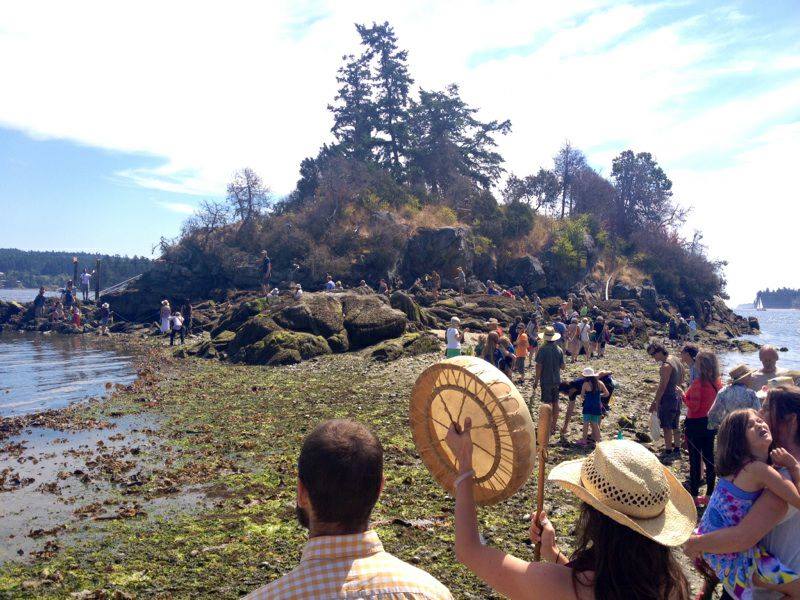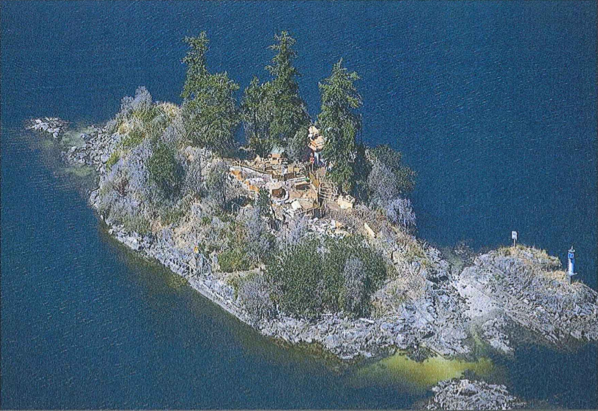Protests against the luxury home being built on Grace Islet, B.C. have continued over the course of this past week, with a group of activists erecting a mock house over graves in Ross Bay Cemetery, Victoria last Monday. Grace islet, which lies just off of Grace Point on Salt Spring Island, one of the Gulf Islands between Vancouver Island and mainland B.C., is just three quarters of an acre and is a known Coast Salish burial site, making the ongoing construction increasingly controversial.
The grave belonged to two ancestors of one of the protesters, Briony Penn, an environmental activist, Salt Spring Island resident and past Liberal candidate for Saanich-Gulf Islands. The placement of the house banner was meant to highlight the differential treatment of Aboriginal and non-Aboriginal burial sites by the government.
The banner was erected shortly after a letter was sent by Chief William C. Seymour of Cowichan Tribes to Steve Thomson, B.C.’s forestry minister, urging him to revoke the alteration permit which allows the luxury home’s construction. Importantly, Chief Seymour claimed that an aerial photo of Grace Islet appears to show that the luxury home is being built on continuous and fully enclosed foundations.
“Our ancestors should not be trapped in concrete. They were buried on this islet for a reason,” Chief Seymour wrote.

The archaeology branch of the forestry ministry approved a plan for the luxury home to be constructed on stilts or pilings, a concession meant to minimize ground disturbances, keep cairns open to the environment and allow outside access. While this was rejected by First Nations parties as unacceptable, Chief Seymour lamented that apparent changes to the design are “far more invasive” than what was originally approved.
Chief Seymour also criticized the absence of inspections or monitoring by archaeologists and First Nations field assistants, which were conditions of the alteration permit, as well as a lack of enforcement by the archaeology branch.
“The Branch chose to ignore the original breach [of boundaries] and not levy any charges, so really there is nothing to stop wanton destruction of this important and ancient site,” Chief Seymour added.
Prior to the recent protest at Ross Bay Cemetery, a number of actions have taken place near Grace Islet, featuring collaboration between area First Nations and local Salt Spring Island residents, both Aboriginal and non-Aboriginal, from whom there is growing support.
On June 21, National Aboriginal Day, dozens of people protested at Centennial Park in downtown Ganges, followed by multiple days of protesters paddling and drumming around the islet and nearby shores.

Christopher Roy, founder of Salt Spring Exchange, expressed that local First Nations communities are “outraged and deeply hurt by the disrespect of the B.C. government and Archaeology Branch,” but praised fellow islanders for their solidarity.
“Salt Spring Islanders stood with First Nations in calling upon the Minister of Forests… to halt the development and negotiate with the owner to purchase the islet for protection.”
Earlier last week, Salt Spring Island resident and activist Joe Akerman led dozens of people to Grace Islet over a shellfish bed at low tide. As Akerman drummed, prayer flags were strung across the land bridge.
“We stood and reflected, sang, cried, laughed and bore witness together; and when we were done, the waters closed over the bridge and Grace stood again on its own,” wrote Gary McNutt, who documented the demonstration.
Dennis Lucarelli, a Salt Spring Island resident and one of the demonstrators, told rabble.ca about his support for preserving the burial site.
“To me, Grace Islet is part of the Salish Sea, which when you think of it, is part of the sacred watersheds of coastal North America that Indigenous peoples called home since long before the settlers arrived from Europe[.]”
Phil Vernon, a community organizer with Salt Spring Islanders for Social Justice and Reconciliation, told rabble.ca that there still has been little movement from the provincial government on Grace Islet.
“The minister’s office has answered emphatically ‘no,’ they’re won’t meet with the Capital Regional District (CRD) board, they’re not going to suspend the permit,” he told said on Wednesday. “They’re stonewalling and in fact spreading misinformation.”

While the provincial government’s position may have remained unchanged, Grace Islet has gained official support locally.
Last Wednesday, the board of the Capital Regional District, the local government entity formed by 13 municipalities on the southern end of Vancouver Island, unanimously called for the province to suspend the permits.
As well, Ben Isitt, a Victoria city councillor and regional director with the CRD, has called on his fellow directors to support the expropriation of Grace Islet, which would transfer ownership of the construction property to the municipality. The luxury home’s owner, Barry Slawsky, would be compensated in exchange. Isitt’s petition currently has 459 signatures, while the BC Green Party leader Adam Olsen’s petition to the provincial government, urging it to cancel the permit, has 974.
Slawsky is an Edmonton-based businessman and former owner of the San Francisco chain of gift stores. He has not responded to requests for mediation, despite past implications from the Ministry that it might attempt persuading him to allow access to collect remains. Band leaders had also reportedly enlisted a rabbi to appeal to him personally.
Slawsky was previously in the news after he was charged under the Copyright Act for using counterfeit safety labels on products at San Francisco. To date he has not publicly commented or met with officials about the site’s development.
The provincial government has previously declined an interview with CBC British Columbia, and Minister Thomson has defended the permit’s approval in the legislature, saying that “in this case… we have followed the process. The permits were reviewed by the Archaeological Branch… but they were issued in a way that ensured the protection of the First Nations heritage resources on that site.”
Last Tuesday, an unnamed government spokesperson claimed to the Eco Report that the Ministry lacked the power to cancel the permit.
Top node photo: John Cameron
Body photos: Grace Islet Facebook group
Cory Collins is a writer, artist and behaviour therapist. He has also written for the Island Review, Cordite Poetry Review, People’s World and Aslan Media. He lives in St. John’s and can be reached via corycollins.ca.




